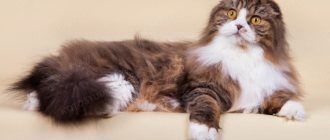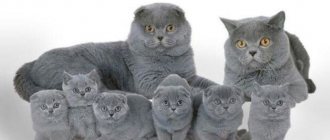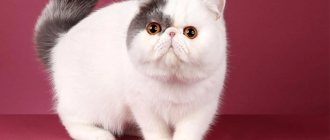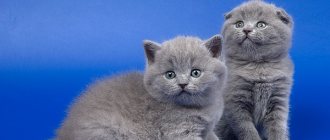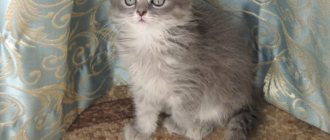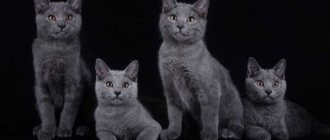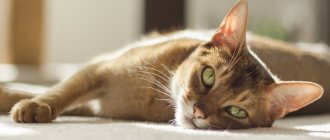The Highland Straight or Scottish pointy-eared longhair cat is one of the rarest and youngest breeds in the world. In Russia there are very few nurseries working on their breeding. But this does not prevent these plush and cute creatures from being very popular. Unlike their proud and independent short-haired Scottish relatives, these animals are very kind, flexible, gentle and loyal.
Highland Straight
Detailed description of the breed
Many people believe that Scottish Highland Straights are no different from Highland Folds, Scottish Straights and Scottish Folds. But this is only at first glance. There are differences and they are quite significant.
Table 1. Description of the Highland Straight breed.
| Part of the body | Peculiarities |
| Body | The body of representatives of this breed is medium in size, squat, with rounded contours, and dense. The width between the shoulders is equal to the measurement of the sacrum. Boning is average, muscles are well developed. The joints move elastically and freely. |
| Limbs | The hind and forelimbs are short. The paws are neat, round in shape, the toes are pressed tightly together. |
| Tail | The tail is of medium length, mobile in all areas. Rounded at the base. Fluffy. |
| Head | The head is rounded. It may seem that it is a bit heavy in relation to the size of the body. The cheeks are plump with dense hair (especially noticeable in cats). The forehead and skull are convex. The chin does not protrude, is well formed, strong, rounded. The neck is thick and short. |
| Nose | The nose is wide, short, slightly arched. Profile with smooth and gently rolling lines. |
| Eyes | The organs of vision are widely spaced, round, and large in size. A look of amazement and surprise. The outer corners of the eyes are slightly raised. |
| Ears | The ears are small, slightly pointed at the tips, wide at the base, and stand straight and high. Inside there are dense and lush hairs. |
| Wool | The fur does not adhere to the body. Very dense, thick, with a pronounced undercoat. Can be long or medium-long. Cats of this breed wear a beautiful and large collar. The fur on the front of the body is noticeably shorter than on the back. |
| Dimensions | The main difference between Highlands and their relatives is the size of the cat. The maximum weight of a male reaches 5 kg, and the minimum is 4.5 kg. Cats weigh less - from 3 to 3.5 kg. However, there are often “girls” who are absolutely not inferior to cats in weight. |
| Color | As for colors, any colors are allowed. It can be plain blue, black, white, red. Two-color wool is also allowed, including color point (without white!). Marble color is possible, as well as brindle, tortoiseshell, tabby, and calico. |
Attention! Dull and disheveled fur and a swollen belly in a Highland Straight indicate his ill health. Therefore, when choosing a kitten you should be careful. Especially if the pet is purchased by hand, and not in a nursery.
Highland Straight cat without defects
Flaws
The disadvantages of highland straights are considered to be:
- crunching in joints;
- back without hump;
- ears too wide, drooping towards the head;
Ears drooping towards the head
- flat forehead;
- irregular skeletal structure;
- wool resembling cotton wool;
- knees close together;
- the stance of the hind limbs, which resembles that of a cow.
Attention! The eye color of Highland Straights must necessarily match the color of the coat.
The color of a cat's eyes matches the color of its fur.
Pros and cons of the breed
The ratio of positive and negative characteristics of the Scottish Straight is as follows:
| Advantages | Flaws |
| Flexible character | Periodic manifestations of obstinacy |
| Loyalty to the owner | Excessive independence |
| Child friendly | Reluctance to be held |
| Get along with other pets | Desire to hunt birds and small rodents |
| Easy to learn | In some cases - reluctance to succumb to training |
| Adaptability | Increased appetite |
| No genetic disorders | Tendency to excess weight and a number of diseases |
This classification is conditional and differentiates the general characteristics of the breed. Animals, like people, can express themselves in different ways, depending on individual heredity and upbringing.
Character
The Highland Straight is a very friendly cat. He is completely non-confrontational and learns everything quickly. The owner will never have problems accustoming the kitten to a tray, scratching post, harness and other useful devices. On the contrary, a pet always likes to get acquainted with something new and unknown.
Highland Straights are very attached to their owner. They choose one person as the object of adoration. Other family members are treated with respect, but not with the same devotion. They love their home and any move, even a short one, can become real stress for them.
Attention! You can understand that your pet is a Highland Straight only after 8 months. Until this time, the ears may tilt down and lie down.
Adorable Highland Straight kitten
The same applies to parting with the owner. Representatives of this breed initially find it very difficult to bear separation from their loved one. However, the feeling of sadness and sadness does not last long. Within a few days, the animal will forget about what happened and calmly switch to another family member. And when the owner arrives, he will pretend that nothing happened.
Pets are very easy to communicate with. They do not impose their company, they can calmly play and sleep completely alone. But as soon as the owner calls out to the pet, he will immediately run headlong to the long-awaited call.
These cats are very friendly
The animal of this breed is devoid of aggression. It prefers to live in love and harmony. Therefore, the owner should take into account that punishment, scolding and spanking are not for Highland Straights. After constant beatings, the cat will simply stop trusting its once loved one. And it will be very difficult to regain trust and love from your pet, since representatives of this breed are quite vindictive and vindictive.
In childhood, kittens are overly active and happily run after every moving object. But as pets age, they become calm and reasonable. After 2 years of age, cats prefer to sleep on a soft sofa rather than run around the apartment chasing a sunbeam. And the older generation will not even raise their paw if a fly lands on their forehead.
Lazy adult highland straight cat
They get along easily with children. The same applies to other pets in the house. These animals are very intelligent creatures. And even if a parrot flies past them or a domestic rat runs away from its cage, they will not harm them, despite their innate hunting qualities. But running after a fly or a bug that accidentally entered the apartment is a real pleasure for Highland Straights (at a young age).
Attention! Cats of this breed can be aggressive towards those who, in its opinion, pose a danger to newborn kittens.
Another feature of this breed is restraint. Long-haired Scots never bother their owner with their meowing. Even if hunger is very noticeable, they will silently wait until they are fed, looking pitifully at the owner.
Highlands happily lie on their backs, bending their heads so that their necks can be scratched. They can lie in this position for a very long time, mentally begging the owner not to stop.
Always on guard
They love to bask on their owner's lap, but not for long. It is impossible to force them to lie next to you or on their stomach. They will come only when they themselves want it.
Highland straights do not tolerate scandals and noise. They always flinch at any knock and try to hide away from sounds that are unpleasant to the ear.
Tendency to diseases
Scottish breed pets cannot be classified as sickly animals. But still, there are certain pathologies that are typical for such cats. The main problem is joint diseases - the lop-eared gene, which makes animals' ears look so unusual, can negatively affect the condition of the musculoskeletal system. True, Scottish straights and highland straights do not have this problem.
A predisposition to some pathology does not necessarily mean that the disease will manifest itself. A loving owner should simply be aware of possible problems in order to take appropriate measures in time. Some of the following pathologies are characteristic of “Scots”, while others can develop in pets of any breed:
Osteochondrodysplasia. The pathology is incurable; specialists prescribe only supportive therapy that can significantly improve the pet’s quality of life. The disease manifests itself as lameness, slow growth, and deformation of the limbs. The tail of animals with this problem is usually short, has low mobility and is thick. The pet has difficulty walking, jumping up and jumping off. The cat is prescribed chondroprotectors and anti-inflammatory drugs - they relieve pain. In some cases, surgical intervention is resorted to. Cardiomyopathy. When sick, lethargy, shortness of breath, and cough may occur. Typically, pets with this pathology are developmentally delayed. The doctor can determine the problem during the next examination. In addition to therapy prescribed by a specialist, your pet must be protected from stress, and taurine supplements must be included in the diet. Urolithiasis disease. It occurs 5 times more often in males than in females. The pathology is manifested by pain when urinating and the appearance of blood in the urine. Your pet may lick the genital area frequently. The first aid that can relieve pain is to apply a heating pad to the stomach. The heat will relieve the spasm and the animal will feel better. With such a problem, you cannot delay visiting the veterinarian. Discharge from the eyes. If they are transparent and not very abundant, this is normal. If they are green, yellow or red, this is a reason to contact a veterinarian. The cause of colored discharge may be infection, worms or low immunity. Obesity. “Scots” are prone to excess weight, but whether the pet becomes obese depends entirely on the owner. Following the principles of proper nutrition will help maintain the animal’s normal weight. Ringworm. Even a pet is at risk of getting sick - spores can be brought into the house by one of the household members on their shoes. Symptoms of the pathology are hair loss, itching, and spots on the skin. Therapy includes the use of Clotrimazole or Miconazole ointment. Good results are obtained by bathing with Nizoral shampoo and injections with Vakderm or Microderm. In severe cases, Griseovulfine tablets are prescribed.
It is important, until the problem is resolved, to carry out regular and thorough cleaning of the house, as well as limit contact with animals, because the disease is also dangerous for humans.
Our Scottish kitten had ringworm. Unfortunately, we discovered the problem late, which led to infection of all family members. The child was especially affected - he was covered all over with spots: lichen was on his face, hands and even on the scalp. The treatment was very long - the child’s affected areas were treated 4 times a day alternately with sulfur ointment, iodine, and the drug Exifin. The animal was helped by the drug Vakderm - after two injections every two weeks, all signs of lichen disappeared.
Timely vaccination, deworming of your pet and periodic examinations by a specialist will help prevent the development of many serious pathologies.
Caring for Highland Straights
Legends can be made about the cleanliness of cats. These long-haired, pointy-eared beauties are also distinguished by their excessive pedantry. They spend hours licking their fur, giving it a well-groomed appearance.
However, Highland Straights cannot cope with so much wool on their own, unlike their Scottish Shorthair counterparts. Hairs can enter the gastrointestinal tract in clumps and lead to intestinal obstruction.
Veterinarians advise brushing this breed's coat daily.
Therefore, veterinarians still recommend daily cat care, which is aimed at combing out the hair. To do this, you can purchase one of these devices:
- a special brush with long metal teeth, rounded at the ends;
- slicker;
- long-toothed mitten;
- furminator (a tool that resembles a small rake);
Furminator for cats with long hair
- crest;
- a double-sided brush (metal teeth on one end, massage bristles made of natural materials on the other).
Attention! An excellent option for combing long-haired cats is to use… your palm soaked in water. Just run it over your pet's fur several times. Dead hairs will remain on the palm.
Cats of this breed (as well as others!) should not be bathed frequently. Once every 4-5 months is enough. To keep your pet's coat silky and smooth, it is recommended to use shampoos specifically designed for medium and long-length coats.
Shampoo for cats with long hair
If the owner wants the animal’s fur to shine and be silky, he should try a little. First, it is recommended to apply degreasing cream to the fur coat and gently rub it in. The product is washed off with warm water. Next, you need to take shampoo and lather it.
Attention! You need to wash off the product thoroughly, otherwise the cat will lick it off, which will cause allergies or stomach and intestinal disorders.
Balms containing nourishing oils will also be useful. They will make the fur coat silkier and will be useful for caring for the coat in winter.
Shampoo for cats with long hair containing oils
The final step in washing is the application of a texturizer - a balm that makes the fur voluminous, prevents the formation of tangles, matting of hairs, and resists electrification.
Spray texturizer
Important! You cannot wash your cat with human balms and shampoos, as this can cause unwanted reactions such as allergies.
You need to dry the fur with a hairdryer. The air should be warm (not hot!), the distance from the animal’s body to the device is 30-40 cm. If the room is warm, you can allow the fur coat to dry naturally.
Important! Highland straights are very clean animals. Therefore, the owner needs to monitor the cleanliness of the tray. Otherwise, the pet may walk past the dirty potty or prefer a more convenient place to relieve its needs.
You can walk with your pets, but only if the cat itself shows interest in this activity. There is no need to buy her an expensive harness and drag her outside if the area outside the house is terrifying to her. Perhaps the cat is a real homebody and a balcony on which birds chirp beautifully is enough for her.
This is how the Highland Straight kitty likes to walk
Otherwise, the care procedures are no different from the others.
- Eye wash. If brown discharge is visible in the corners or the cat’s eyes are constantly watering, then you need to use a sterile cotton swab dipped in regular black tea. Pharmacies sell special products that allow you to treat the organs of vision. You need to wipe from the inside of the eye and aim for the outside.
How to wash a cat's eyes at home if you don't have pharmaceuticals on hand
- The ears are washed with ordinary water, with which the bandage turunda is soaked. The frequency of the procedure is 1-2 times a month. If the owner notices that the pet often shakes its ears and tries to get its paws into it, then cleaning should be done immediately.
A cat's ears can rightly be called its strongest and weakest point. It is well known that a cat's hearing is much more developed than a human's. Thanks to him, cats are able to track mice, even when they make virtually no sound, and escape from predators by recognizing their approach in advance. You can read more about how to clean your cat's ears at home in our separate article.
Maintenance and care
Highland cats are very clean and have fairly good health. They tolerate cold well, do not like heat
Particular attention should be paid to their tray and eating utensils; these aristocrats love cleanliness. There are no special recommendations to maintain good health; vaccinations and good food will be enough
They are relaxed about bathing, but you should not bathe them too often; once every three months will be enough. Wash with products intended for long-haired cats. Then dry them with a hairdryer using warm air.
It is advisable to feed Highland Straight with food for purebred cats. These foods are of higher quality and are made from expensive bases. They should include all the necessary vitamins and nutrients. Although Straights are in good health, they are often calcium deficient. You need to be careful with cheap food; there are a lot of fakes and low-quality products among them.
You should not leave a lot of food in the bowl at once; cats are prone to overeating. When feeding food, do not forget to monitor the availability of water. These cats are not against natural food, but it takes more time and effort.
The normal human diet is not acceptable for them, and health problems may arise. For details about feeding, you should contact the breeders; a sudden change in diet can adversely affect health.
Health
Scottish Highland cats have good health. They are hardy. To date, no genetic diseases have been identified in straight cats. Sometimes they may experience problems with the spine and joints as they age, due to a reluctance to move.
Highland Straight breeders recommend keeping them out of direct sunlight.
Attention! To maintain the proper microclimate in the room where the cat lives, it is necessary to install an air humidifier.
If you feed your cat correctly and follow all grooming procedures, then its lifespan can be increased to 20 years, with an average lifespan of 12-15 years.
Well-groomed Highland Straight kitten
Maintenance and care
Highland cats are very clean and have fairly good health.
They tolerate cold well, do not like heat. Particular attention should be paid to their tray and eating utensils; these aristocrats love cleanliness. There are no special recommendations to maintain good health; vaccinations and good food will be enough
They are relaxed about bathing, but you should not bathe them too often; once every three months will be enough. Wash with products intended for long-haired cats. Then dry them with a hairdryer using warm air.
It is advisable to feed Highland Straight with food for purebred cats. These foods are of higher quality and are made from expensive bases. They should include all the necessary vitamins and nutrients. Although Straights are in good health, they are often calcium deficient. You need to be careful with cheap food; there are a lot of fakes and low-quality products among them.
You should not leave a lot of food in the bowl at once; cats are prone to overeating. When feeding food, do not forget to monitor the availability of water. These cats are not against natural food, but it takes more time and effort.
The normal human diet is not acceptable for them, and health problems may arise. For details about feeding, you should contact the breeders; a sudden change in diet can adversely affect health.
Nutrition
Only the owner decides what to feed the Highland Straight. Representatives of this breed have good health, and therefore problems with the gastrointestinal tract rarely occur. The best option is to switch an adult cat to dry food. Definitely premium and super premium (Royal Canin, Hills, Lams, ProPlan, etc.). These foods contain all the necessary vitamins, minerals, and microelements necessary for the health and physical development of the animal (unlike advertised canned food).
Elite dry food for sterilized adult cats Royal Canin
If the owner prefers to feed his pet exclusively self-prepared food, then the main products in his diet should be:
- dietary meat;
- cereals;
- kefir;
- greenery;
- vegetables;
- vitamin supplements.
Attention! Under no circumstances should Highland Straights be fed table food. This can negatively affect his health and, as a result, his life expectancy. You can read more about what you should not feed cats in our separate article.
Most of the menu of representatives of this breed is meat. Pieces of beef, rabbit, chicken, and turkey scalded with boiling water should be in your pet’s bowl every day.
It is ideal if you mix meat with boiled or raw vegetables, cereals, and offal. As for cereals, only buckwheat or rice is included in the animal’s diet.
Chicken pieces
Every day the Highland Straight menu should include kefir, heated to room temperature. As an alternative to this fermented milk product, you can offer low-fat fermented baked milk or yogurt.
Milk (especially cow's milk) is on the prohibition list. It can cause abdominal pain, indigestion and intestinal obstruction. The same applies to fish. This product, with constant use, often leads to the development of cholelithiasis.
Feeding
The diet should include vitamins, micro- and macroelements, protein, and fiber. It is important to choose the type of feeding that suits your pet. In one case, you can feed with natural food. The diet may include lean meat (rabbit, turkey, veal, chicken), meat by-products, sea fish, cereals, vegetables, herbs, eggs, low-fat dairy products. You should not feed your cat fatty, spicy, or sweet foods.
Feeding with natural food
Dry food is suitable for feeding Highland Straights. They are complete food for cats. They include protein, grains, and meat by-products. It is important to buy premium, super-premium or holistic food. Economy feeds complicate the functioning of the gastrointestinal tract.
To avoid dehydration, refill your bowl with clean water regularly.
Health
Highland Straights have good health and strong immunity, due to the absence of the lop-eared gene. However, the breed has a tendency to certain diseases:
- Turn of the century
This problem was transmitted to the Highland Straights from the Persians. Cats have weakened eyelid muscles and ligaments, causing the cornea to curl and rub against rough skin. Sometimes severe inflammation of the eyes may occur. Symptoms of the disease are lacrimation and redness.
- Obesity
The breed likes to lead a quiet lifestyle and does not like active games, so individuals often experience excess weight. The consequences can be joint problems and diabetes.
- Hypertrophic cardiomyopathy
The Scottish people also inherited thickening of the heart walls from the Persians. The consequence may be poor circulation. Symptoms of the disease are shortness of breath, fainting, high blood pressure.
To prevent diseases, it is worth getting vaccinated against chlamydia, calcivirus, rabies, and plague. With proper care, a cat will live 15-18 years.
Interesting facts about the origin of Highland Straights
The previous generation of Scottish Highland Straights were wild cats. These animals were hunted in the high mountains of Scotland in the 18th century. It’s hard to believe, but it was these predators who became the parents of beautiful and gentle Highland Straights.
The first exhibition of the pointy-eared longhaired Scots took place only in the 70s of the 20th century, when their relatives - the Highland Folds - were already showing off with might and main at cat shows in the early 19th century. And all because straight-eared Scottish dogs were then considered defective.
Beautiful cat of the Highland Straight breed
Official confirmation of the breed might not have happened if the scientists involved in breeding new breeds did not want to conduct a series of experiments during which it was planned to improve the fluffy Scottish. The first crossing of a Scotsman occurred with a Persian cat, then with a British one. The result of the experiment was amazing. Thanks to this relationship, a large number of colors were obtained.
After some time, the Highland Scottish Straight and Highland Scottish Fold breeds were developed. Their main difference is the shape of the ears. In the former they are straight and sharp, in the latter they are inclined towards the head (loop ears).
Highland straight
Scots with long hair were officially recognized in the late 90s of the 20th century. Since that time, Scottish cats with straight ears have been honored guests at cat shows.
Highland straights are a very rare breed with their own characteristics. They are unpretentious, do not require special care and do not require feeding with elite food. They do not tolerate noise, scandals, quarrels, a dirty tray, or an unwashed food bowl. If you follow all the recommendations for caring for your pet and proper nutrition, your pet will please its owner for 20 long years.
Origin of Scottish cats
It’s hard to believe, but the Scottish breed did not appear as a result of the ideas of breeders and their long, painstaking work.
The first Scottish kitten was the result of a natural genetic mutation that unexpectedly occurred about fifty years ago in an ordinary white cat from Scotland.
The kitten was born with small, floppy ears. For a long time it was considered simply defective and no interest was shown in this peculiar animal. This could have continued and such an amazing breed would not have been born if not for William and Mary Ross. The couple liked the cat with strange ears, and when she grew up and gave birth to kittens, they acquired one of her cubs - a girl who was christened Snooks.
When Snooks grew into an adult cat, she was matched with an ordinary domestic cat. Their litter included two kittens with the same floppy ears as their mother. The history of Scottish fold cats began with these kittens.
Scottish Folds or British Folds, as they are also called, due to the fact that they are descended from British Shorthair cats, are still not officially recognized in Scotland as a separate, self-sufficient breed of cat. Which is quite strange - after all, they originated from there. This is due to the fact that Scottish veterinarians have concerns regarding the ears of this breed. They believe that their structure can lead to deafness of the animal or to the spread and development of various infections.
In the litter of cats of the Scottish breed, both fold-eared kittens and kittens with straight ears are born. This is the main feature of the Scots. This phenomenon is explained by the fact that when mating, one of the parents must have straight ears. Only in this way can the gene that determines lop ears be passed on to one of the offspring with a fifty percent probability. If you try to breed a Scottish cat with a Scottish cat, the kittens from their litter will have unpleasant birth defects.
At the beginning of 1970, in England they decided to stop working on Scottish breeding, as they discovered problems with the musculoskeletal system due to the genetic characteristics of the breed. At the same time, American geneticists were able to preserve the mutation of the ears, eliminating problems and harm to the health of fold-eared cats. In 1980, the breed gained popularity and veterinarians had to recognize it and define standards for Scottish representatives. In 1994, the American Cat Fanciers Association officially recognized the Scottish Fold as a separate breed.
What is the difference between the British and Scottish breeds?
Scottish Straight kittens have very small ears that curve forward. Unlike British cats, Scottish cats:
- graceful and light;
- their head is round in shape;
- longer body.
On average, Scottish Fold and Scottish Straight cats weigh three to three and a half kilograms, cats four to five kilograms. The British are heavier and larger than their Scottish counterparts.
It is often believed that there is a British Fold breed, but this is not true. There is a British Shorthair, but it has its own standards and is not a fold-eared cat.
Breeders sometimes cross Scottish and British cats and cats, but these species have long been separated. Crossbreeding is used to obtain new rare colors.
Long-haired straight-eared and fold-eared (differences)
Highland Fold and Highland Straight cats are practically no different from each other in appearance, with the exception of the shape of the ears. Scots Folds are characterized by small, wide-set ears with curved tips.
Straight-eared Highland Straight cat
But the character of these Scots is very distinctive:
- straight cats are distinguished by their independent disposition, they do not particularly like excessive affection and “get-togethers” in the arms of the owner;
- Folds are loving cats, ready to sit in the arms of their owner all day long, accepting affection with incredible pleasure.
